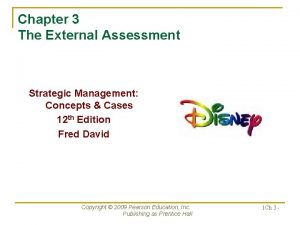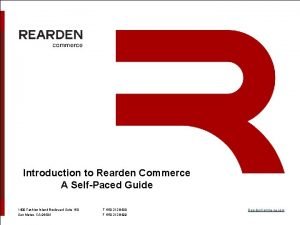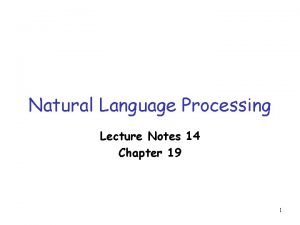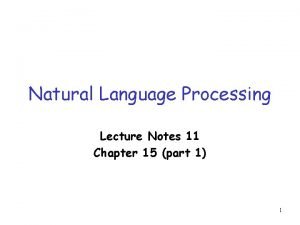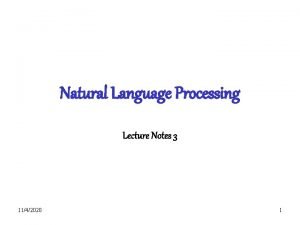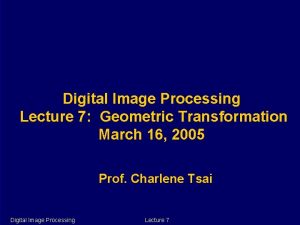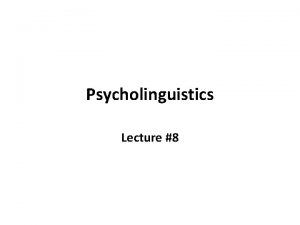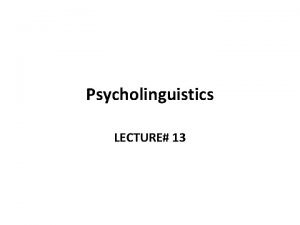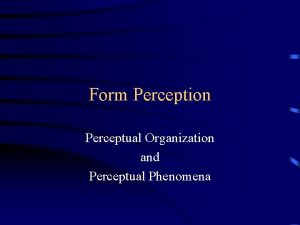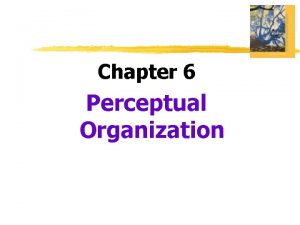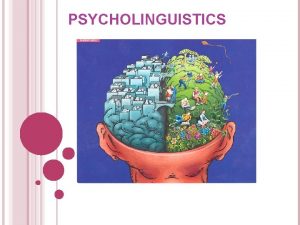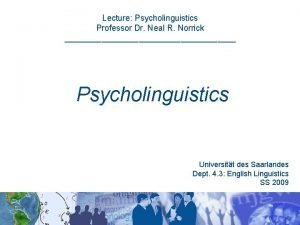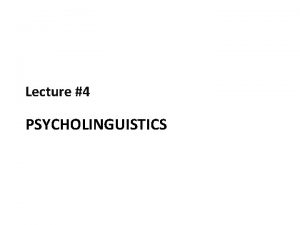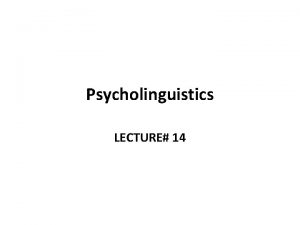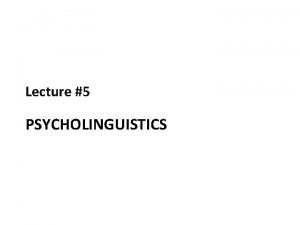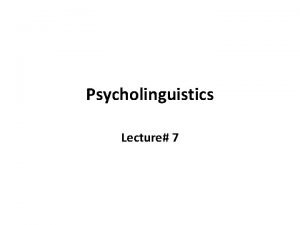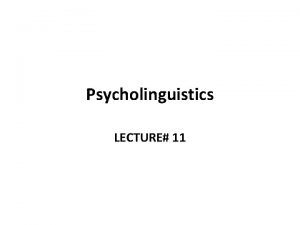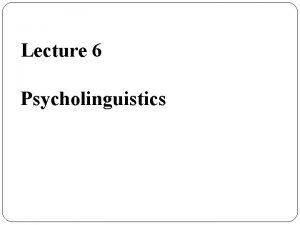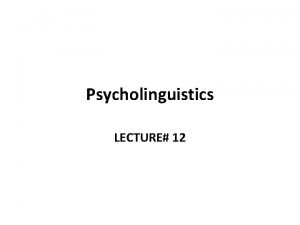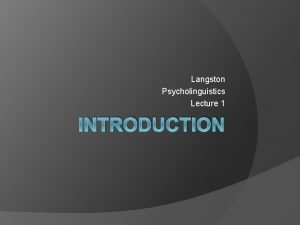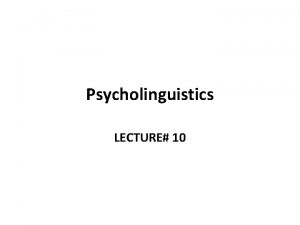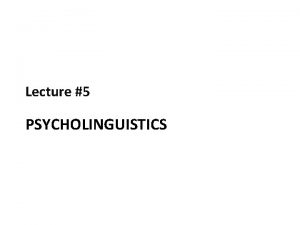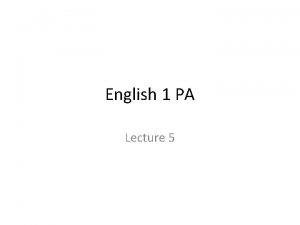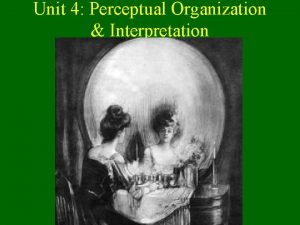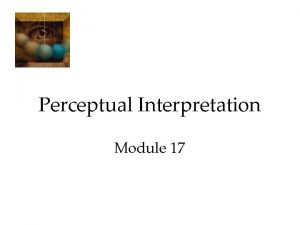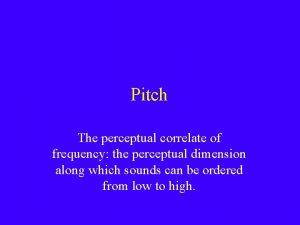Psycholinguistics Lecture 8 Psycholinguistics Perceptual processing Although virtually

























- Slides: 25

Psycholinguistics Lecture #8

Psycholinguistics • Perceptual processing. • Although virtually no research has addressed the development of the sensory stores per se, there is a substantial literature on perceptual processing defined more broadly. • Prior to the early 1960 s, it was generally believed that the infants perceive the world in a disorganized way. • “The baby, assailed by eyes, ears, nose, skin, and entrails at once, feels it all as one great blooming, buzzing confusion” (W. James, 1890, p. 488).

Psycholinguistics • Subsequent research, however, indicates otherwise. • In a research by Fantz (1963) for example, babies were shown various forms while observers recorded how long the infants looked at each one. • The infants look at some patterns more than others. • Fantz interpreted this finding as meaning that the infants could distinguish among the forms and preferred some to the others. • Fantz found that young infants preferred patterns such as faces or checkerboards over plain stimuli.

Psycholinguistics • More details about experimental techniques and paradigms to study infants’ early visual preferences in Karmiloff-Smith & Karmiloff, 2001, p. 40 -46 • Just as the human face, for whatever reason, fascinates infants, so does the human voice. • Various studies indicate that infants are biologically prepared to distinguish between speech and other sounds. • For instance, Condon & Sander (1974) have shown that infants make synchronized movements (e. g. , raising a finger, kicking a leg, etc. ) to individual speech sounds shortly after birth.

Psycholinguistics • Frame by frame analysis of these movements indicated that they were synchronized with the syllables in the speech signal. • Newborns show this synchrony with different languages but not with non-speech sounds like the tapping of a pencil.

Psycholinguistics • A famous study by Eimas et al. (1971) showed that infants make distinctions between different speech sounds very early in life. • In this study, they examined infant’s perception of the voicing contrast in English (contrasting /ba/ for which Voice onset time VOT = 0 ms and /pa/ for which VOT = 40 ms). • Eimas and colleagues used a technique known as habituation paradigm to study infant’s responses to these stimuli. (See Karmiloff-Smith & Karmiloff, 2001, p. 20 seq. ).

Psycholinguistics • Habituation refers to the decline in a response to a stimulus following repeated presentation of the stimulus. • The response studied is referred to as nonnutritive sucking and involves a special pacifier that is connected to a computer that measures the number of sucks an infant makes. • When /ba/ was initially presented, the infant showed great interest, and the sucking rate was high; but with repeated presentations, the sucking decreased. • At this point, a new stimulus was presented. On some occasions it was a stimulus from the /ba/ category (VOT between 0 and 25 ms), and on other occasions it was a stimulus from the /pa/ category (VOT between 25 and 40 ms).

Psycholinguistics • The interesting result was that sucking returned briefly to a high level (dishabituation) if the new stimulus was from a different category, but not if the new stimulus was from the same category. • Non-nutritive sucking technique • Taken together, studies of perceptual processing by infants reveal infants to have rather sophisticated perceptual skills at birth or shortly after birth. • These results at least suggest that infants are well equipped at birth to process linguistic stimuli.

Psycholinguistics • Short-term STM and Working memory WM • A second aspect of the cognitive system that has been examined developmentally is short-term memory. • A common test of STM in grade school children is the simple memory span test: • the children are presented with a list of numbers and asked to recall them (some times in forward order and sometimes in backward order). • It is clear that there are significant differences between older and younger children on this task.

Psycholinguistics • In fact, the simple memory span test is a standard feature on intelligence test for that very reason. • See Dempster, F. N. (1981). Memory span: Sources of individual and develomental differences. Psychological Bulletin, 89, 63 -100. • These results, however, do not tell us much about the development of working memory. • WM indeed consists of both storage and processing functions, and these compete for limited resources.

Psycholinguistics • Thus, a development change in either of these functions would affect the other. • In particular, if children become more efficient in processing numbers, fewer resources would be needed for that function, thereby leaving more resources available for storage. • In this way, simple memory span might improve without any change in the total size of working memory.

Psycholinguistics • A series of elegant experiments by Case et al. (1982) has confirmed this analysis. • In their first experiment, 3 - to 6 -year-olds were given a storage and a processing task. • The storage task was a simple memory task of remembering a list of seven words. • The processing task was a repetition task, in which the children had to repeat auditory presented words. • The investigators measured the time between the presentation of the word and the onset of the child’s vocal response.

Psycholinguistics • The same words were used in both tasks. Case et al. found a negative correlation between the two tasks: as response time increased (reflecting processing load), memory span decreased. • Older children remembered more words than younger children, but when their reaction time was taken into account, there were no differences between the two age groups.

Psycholinguistics • A second experiment presented adults with the same two tasks, using non-sense words (with which adults have no familiarity). • Adults’ reaction time to non-sense words was slow, comparable to younger children’s reaction time to real words. • If memory span depends upon processing speed, then adults’ recall of the non-sense words should also be similar to the younger children’s recall of real words, and it was. • The studies thus demonstrated that when adults are slowed down to children’s speed of processing, memory span differences disappear.

Psycholinguistics • Case and colleagues concluded that there is no substantial increase in overall working memory capacity with development, at least from 6 years to adulthood. • Under this interpretation, simple memory span shows a functional increase in storage due to the greater efficiency of processing. • This notion of developmental changes in processing efficiency is highly relevant to understanding early reading by children

Psycholinguistics • Conclusion • Globally speaking, observed differences between children and adults on cognitive tasks have more to do with the use of information processing resources than with qualitative shifts in thinking (as it is somehow suggested by Piaget’s interpretation of cognitive development). • The major change over time is an increase in efficiency, or a decrease in the amount of cognitive capacity required for a particular task. • Increased efficiency enables a child to do simultaneously two or more tasks, or a complex task with two or more components. • This is directly pertinent to language acquisition.

Psycholinguistics • Indeed, in order to acquire a language, a child must perform correct analyses simultaneously on the phonological, morphological, syntactic, semantic and pragmatic levels. • A child of 3 years old may approach the task in a way that is similar to adults, but less efficient. • For example, when working on new syntactic structures (which is a demanding task), the child may compensate by attending less to phonological specification. • Perhaps only later when the syntax becomes a little easier, will the child be able to master both levels simultaneously.

Psycholinguistics • Language Acquisition by A child: • All normal infants are highly receptive to speech sounds even a few days after their birth. • From the very beginning, children appear to discriminate speech from non-speech and seem to pay particular attention to the human voice as opposed to other environmental sounds.

Psycholinguistics • An infant is particularly sensitive to its mother’s voice. • As Kess (1992) observes, in many cases, it is sensitive to its own mother’s voice while still in the womb. • Eimas et al. (1985) observe that infants perceive some sounds in a categorical way from as early as one month of age.

Psycholinguistics • According to the latest research, an infant can distinguish between two syllables differing only in voicing (/pa/vs/ma/) stop consonants and semivowels (/b/vs/w/), between contrasts in both voicing and place of articulation (/v/vs/s/), and even contrasts in tongue height and placement (/a/vs/i/). • It cannot discriminate the voicing contrast/s/-/z/; but it can discriminate the stop contrast /p/ -/b/.

Psycholinguistics • The infants have not enough knowledge to discriminate the voicing feature, they only do what adults do in making discrimination. • As kess (1992 -286) suggests, “Infants may begins life with a generalized ability for categorical perception, using some system of feature detectors that pay attention to certain acoustics properties.

Psycholinguistics • Such properties are ones that involve possible speech categories in human languages; • Thus, the effect of linguistic experience is the loss of the ability to discriminate those differences which are not phonetic in the language they acquire. ” • Infants can make distinction only in their parents’ language. • They lose the ability to detect distinctions that do not occur in the native language.

Psycholinguistics • Werker and her colleagues (1984) observe that 6 -8 months old children from an English background begin to distinguish contrast that occur in other languages. • At the age of 12 months, they develop their sense of distinction to a great extent. • In the beginning, it was assumed that merely imitation or mechanical repetition was enough for a child to acquire language.

Psycholinguistics • As we have discussed in this topic earlier, infants grasp the mother’s language and try to imitate. • Before the 1950 s, the people had this conception that children imitated adults around them, and that their speech gradually became more accurate. • But in later stages, it was observed by psycholinguists that mere imitation or mechanical repetition is not enough for a child to acquire language.

Psycholinguistics • They also require natural exposure. • Both nature and nurture influence the acquisition of language in children. • Psycholinguists argue that language learning is entirely the product of experience and environment around us. • Some others have suggested that everybody has an innate language learning mechanism which determines learning or acquisition of language identical for each of us.
 Competition in virtually all industries is
Competition in virtually all industries is Sabre virtually there
Sabre virtually there Internal and external assessment in strategic management
Internal and external assessment in strategic management Rearden commerce
Rearden commerce Virtually anything is possible
Virtually anything is possible Virtually all weather occurs in the
Virtually all weather occurs in the 01:640:244 lecture notes - lecture 15: plat, idah, farad
01:640:244 lecture notes - lecture 15: plat, idah, farad Natural language processing lecture notes
Natural language processing lecture notes Natural language processing lecture notes
Natural language processing lecture notes Natural language processing lecture notes
Natural language processing lecture notes Natural language processing nlp - theory lecture
Natural language processing nlp - theory lecture Natural language processing lecture notes
Natural language processing lecture notes Image processing lecture notes
Image processing lecture notes Fluorocein
Fluorocein Nlp lecture notes
Nlp lecture notes Histogram processing in digital image processing
Histogram processing in digital image processing Morphological
Morphological Neighborhood processing
Neighborhood processing Parallel processing vs concurrent processing
Parallel processing vs concurrent processing Top-down vs bottom-up processing
Top-down vs bottom-up processing Top down vs bottom up psychology
Top down vs bottom up psychology Primary and secondary processing of food
Primary and secondary processing of food A generalization of unsharp masking is
A generalization of unsharp masking is Bottom up processing vs top down processing
Bottom up processing vs top down processing Batch processing and interactive processing
Batch processing and interactive processing Point processing operations in image processing
Point processing operations in image processing


